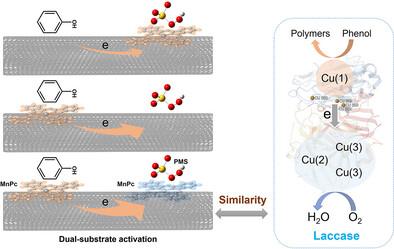The Laccase-Like Mechanism in Peroxymonosulfate-Based Oxidation System for Water Decontamination: Dual-Substrate Activation
IF 16.9
1区 化学
Q1 CHEMISTRY, MULTIDISCIPLINARY
引用次数: 0
Abstract
This study demonstrates that direct electron transfer (DET)-dominated peroxymonosulfate (PMS)-based advanced oxidation processes (PMS-AOPs) share a similar oxidation mechanism with laccase, including dual-substrate activation, DET mechanism, polymerization of organic pollutants, and relatively high redox potential at active site. To verify this point, a detachable catalyst (MnPc/CNT) was used. Neither manganese phthalocyanine (MnPc) nor carbon nanotubes (CNT) could efficiently catalyze PMS to remove phenol (PE), whereas MnPc/CNT achieved complete PE elimination primarily through a DET mechanism. In this process, PE was mainly removed via polymerization. Importantly, galvanic cell experiments and density functional theory calculations showed that MnPc/CNT can simultaneously activate both PE and PMS, whereas MnPc or CNT alone cannot. This dual-substrate activation phenomenon was seldom reported in PMS-AOPs. Comparative studies showed that MnPc/CNT, FePc/CNT, and CoPc/CNT exhibited significantly higher PE removal efficiency than NiPc/CNT, CuPc/CNT, and ZnPc/CNT, which correlated with their higher open circuit potentials. Since current catalyst design strategies for PMS-AOPs remain largely empirical and enzyme is highly efficient catalyst, this laccase-like mechanism means that the laccase-mimetic approach will be a promising direction for developing high-performance catalysts.

过氧化单硫酸盐基氧化系统中漆酶类机制:双底物活化
本研究表明,以直接电子转移(DET)为主导的过氧单硫酸根(PMS)为基础的高级氧化过程(PMS- aops)与漆酶具有相似的氧化机制,包括双底物活化、DET机制、有机污染物的聚合以及活性位点较高的氧化还原电位。为了验证这一点,使用了可拆卸催化剂(MnPc/CNT)。酞菁锰(MnPc)和碳纳米管(CNT)都不能有效地催化PMS去除苯酚(PE),而MnPc/CNT主要通过DET机制实现PE的完全去除。在该工艺中,PE主要通过聚合去除。重要的是,原电池实验和密度功能理论计算表明,MnPc/CNT可以同时激活PE和PMS,而MnPc或CNT单独不能。这种双底物激活现象在PMS-AOPs中很少报道。对比研究表明,MnPc/CNT、FePc/CNT和CoPc/CNT对PE的去除效率显著高于NiPc/CNT、CuPc/CNT和ZnPc/CNT,这与其较高的开路电位相关。由于目前PMS-AOPs的催化剂设计策略在很大程度上仍然是经验的,酶是高效的催化剂,这种类漆酶的机制意味着模拟漆酶的方法将是开发高性能催化剂的一个有前途的方向。
本文章由计算机程序翻译,如有差异,请以英文原文为准。
求助全文
约1分钟内获得全文
求助全文
来源期刊
CiteScore
26.60
自引率
6.60%
发文量
3549
审稿时长
1.5 months
期刊介绍:
Angewandte Chemie, a journal of the German Chemical Society (GDCh), maintains a leading position among scholarly journals in general chemistry with an impressive Impact Factor of 16.6 (2022 Journal Citation Reports, Clarivate, 2023). Published weekly in a reader-friendly format, it features new articles almost every day. Established in 1887, Angewandte Chemie is a prominent chemistry journal, offering a dynamic blend of Review-type articles, Highlights, Communications, and Research Articles on a weekly basis, making it unique in the field.

 求助内容:
求助内容: 应助结果提醒方式:
应助结果提醒方式:


